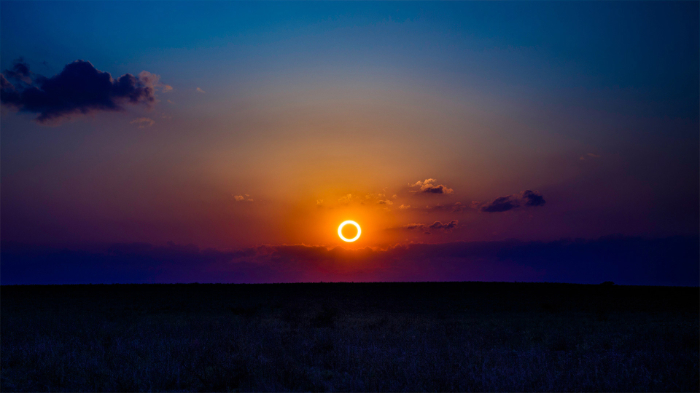| 2023 Oct 14: A Ring of Fire (2023-9-18) ⬅︎ |
 |
A special type of solar eclipse known as an annular eclipse will be occurring on October 14. For about 5 minutes the Sun will appear as a bright but narrow ‘ring of fire’ surrounding a dark silhouetted Moon. Cool!
To view the ring, you’ll need to be within the path of annularity. In the US, this path will begin in Oregon and extend to California, Nevada, Utah, Colorado, Arizona, New Mexico, and Texas. The path is a bit over 100 miles wide but to view the eclipse at its best, you’ll need to be as close to the path’s center as possible.
Sadly, from the Starry Hill region (western Washington), the eclipse will be only partial -- still cool but no ring of fire. So we recommend traveling to around the town of Sutherlin, Oregon. The eclipse there will begin about 8:05 AM and continue to 10:40 with the period of annularity occurring from about 9:16 AM to 9:21. These times can be used for western Washington also.
⚠️ Warning: Unlike a total solar eclipse, in an annular eclipse the sky will never become dark so eclipse glasses are essential throughout.
Here’s the science behind an annular eclipse:
In a general sense, the Sun and Moon have a special ‘dance’ that they’ve been performing in our sky for eons. During their month-long routine, the Sun causes the Moon to wax (brighten) for about two weeks, wane (dim) for another two weeks, and then disappear for a few days only to restart the cycle at a point known as a New Moon. It is at a New Moon when a solar eclipse can occur but only if the geometry is just right.
Due to Earth’s orbit of the Sun, the Sun appears to travel across our sky along a path known as the ecliptic. Its motion is a very slow 1° per day which is about the width of a finger held up at arm’s length. So it takes the Sun about a month to travel through each constellation of the zodiac and a year to complete its 360° orbit of our sky.
The Moon also appears to travel the ecliptic but its journey is different in two big ways… 1) the Moon travels twelve times faster than the Sun taking only about a month to make the full loop, and 2) unlike the Sun which travels the ecliptic precisely, the Moon travels a bit above or below it, crossing the ecliptic twice during its journey.
Key idea: a solar eclipse occurs when the Moon passes the Sun (New Moon) and crosses the ecliptic at the same time.
In the video below, you can see this play out. It shows the Moon's and Sun's journeys along the ecliptic in the morning from October 1 through October 14, 2023. Notice how fast the Moon is compared to the Sun. Also notice the Moon crossing the ecliptic as it passes the Sun.
So this leads to the question, why is the eclipse on October 14 annular and not total? This has to do with the varying sizes of Sun and Moon.
Amazingly, the Sun and Moon have nearly identical angular sizes in our sky: 0.5° or 30 arc-minutes. How can this be considering that the Sun’s diameter is about 400 times larger than the Moon’s diameter? It is because the Sun is also about 400 times further away…. what a truly amazing coincidence!
Their sizes actually vary a little bit because the Moon and Earth travel in elliptical orbits rather than perfectly circular orbits. So the Moon's size varies from about 29.2 to 33.2 arc-minutes while the Sun's size varies from about 31.4 to 32.5 arc-minutes. These tiny differences are not noticeable to our eyes but they are enough to affect eclipses.
During the eclipse on October 14, the Moon will be just 30.2 arc-minutes while the Sun will be 32.0 -- a difference of 1.8. So a narrow 0.9 arc-minute ring of bright photosphere will remain visible as a ‘ring of fire’ as shown here:
An interesting fact is that, in time, all solar eclipses will be annular and none will be total. This is because the Moon is slowly receding from Earth at a rate of 4 cm per year and thus getting smaller in our sky. Not to worry though since it will take over 500 million years before this happens!
|
| |



